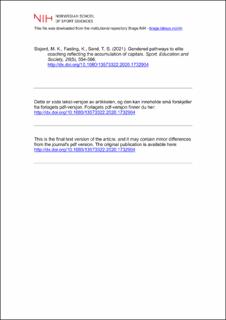| dc.contributor.author | Sisjord, Mari Kristin | |
| dc.contributor.author | Fasting, Kari | |
| dc.contributor.author | Sand, Trond Svela | |
| dc.date.accessioned | 2021-11-25T10:44:14Z | |
| dc.date.available | 2021-11-25T10:44:14Z | |
| dc.date.created | 2021-06-05T20:49:25Z | |
| dc.date.issued | 2021 | |
| dc.identifier.citation | Sport, Education and Society. 2021, 26 (5), 554-566. | |
| dc.identifier.issn | 1357-3322 | |
| dc.identifier.uri | https://hdl.handle.net/11250/2831456 | |
| dc.description | Dette er siste tekst-versjon av artikkelen, og den kan inneholde små forskjeller fra forlagets pdf-versjon. Forlagets pdf-versjon finner du her: https://doi.org/10.1080/13573322.2020.1732904 / This is the final text version of the article, and it may contain minor differences from the journal's pdf version. The original publication is available here: https://doi.org/10.1080/13573322.2020.1732904 | |
| dc.description.abstract | While earlier research on coaches’ careers and the development of coaching expertise appears ‘gender blind’, the focus of this article on the underrepresentation of women in elite-level coaching is how various forms of capital interact in recruitment to coaching. Using Bourdieu's analytic concepts, the study explores Norwegian female and male elite-coaches’ pathways to coaching positions with respect to qualifications and recruitment procedures. Qualifications are understood as being both individual athletic performance level (physical and symbolic capital) and coaching education (cultural capital). Qualitative interviews were completed with 24 female and 12 male elite-level coaches. The findings revealed that relatively more women than men had previously been elite-level athletes. The majority of the participants had coaching education from the sports organisations, while a few had coaching education from their university studies. Relative to gender, two men had no coaching education and several women had completed a programme developed by the sport organisations – with the aim of increasing women's participation in elite-level coaching. Recruitment of coaches seemed to happen through informal channels, which indicates the benefits of social capital acquired through acquaintances and social networks. This indicates symbolic capital in terms of individual athletic achievement. The use of Bourdieu’s analytic concept of capital and the ‘labyrinth’ metaphor facilitated identification and understanding of the longer pathways and challenges women must negotiate on their way to elite-level coaching positions when compared to men. The article closes with the implications of the findings, with particular attention to coaching education and the recruitment/employment procedures of coaches. | |
| dc.language.iso | eng | |
| dc.subject | elite coaching | |
| dc.subject | gender | |
| dc.subject | Bourdieu | |
| dc.subject | capital | |
| dc.subject | labyrinth | |
| dc.subject | qualifications | |
| dc.subject | employment | |
| dc.title | Gendered pathways to elite coaching reflecting the accumulation of capitals | |
| dc.type | Peer reviewed | |
| dc.type | Journal article | |
| dc.description.version | acceptedVersion | |
| dc.source.pagenumber | 554-566 | |
| dc.source.volume | 26 | |
| dc.source.journal | Sport, Education and Society | |
| dc.source.issue | 5 | |
| dc.identifier.doi | 10.1080/13573322.2020.1732904 | |
| dc.identifier.cristin | 1913917 | |
| dc.description.localcode | Institutt for idrett og samfunnsvitenskap / Department of Sport and Social Sciences | |
| cristin.ispublished | true | |
| cristin.fulltext | postprint | |
| cristin.qualitycode | 2 | |
